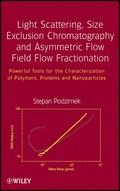Light Scattering, Size Exclusion Chromatography and Asymmetric Flow Field Flow Fractionation
Powerful Tools for the Characterization of Polymers, Proteins and Nanoparticles

1. Auflage Februar 2011
372 Seiten, Hardcover
Fachbuch
Kurzbeschreibung
Light scattering measurements bring valuable information about the molecular size and intensity of interactions of polymer molecules with a solvent. The book provides understanding of the basic theory and principles of light scattering, size exclusion chromatography, and asymmetric flow field fractionation. Including numerous examples of the real applications of particular methods and their combinations for various synthetic and natural polymers, proteins and nanoparticles, this book is ideal for students, researchers, and teachers in laboratories of polymer, biotech, and pharmaceutical research and quality control.
This book focuses on three important methods of polymer analysis: light scattering, size exclusion chromatography (SEC) and asymmetric flow field flow fractionation (A4F). These methods are important primarily in polymer science, but also in advanced materials science and emerging technologies. Readers will learn how light scattering measurements can easily provide absolute molar mass and size without any calibration or using reference standards and how its potential can be multiplied by the combination with a separation technique. Current users of conventional SEC will learn that a light scattering detector effectively solves the crucial problem of SEC, i.e. the column calibration, significantly improves reproducibility of SEC measurements and provides much additional information. In addition, they will see that A4F can overcome many traditional SEC problems, such as interactions of polymers with column packing, shearing degradation and limited separation of ultra-high molar mass polymers.
The book also provides understanding the basic theory and principles of light scattering, SEC and A4F. The theoretical part is accomplished by numerous examples of the real applications of particular methods and their combinations for various synthetic and natural polymers, proteins and nanoparticles. Special attention is paid to the characterization of branched polymers.The book targets beginners as well as the experienced users who need to confirm their own understanding or help interpret their results.
1 Polymers.
1.1 Introduction.
1.2 Molecular Structure of Polymers.
1.2.1 Macromolecules in Dilute Solution.
1.3 Molar Mass Distribution.
1.3.1 Description of Molar Mass Distribution.
1.3.1.1 Distribution Functions.
1.3.1.2 Molar Mass Averages.
1.4 Methods for the Determination of Molar Mass.
1.4.1 Method of End Groups.
1.4.2 Osmometry.
1.4.2.1 Vapor Pressure Osmometry.
1.4.2.2 Membrane osmometry.
1.4.3 Dilute Solution Viscometry.
1.4.3.1 Properties of Mark-Houwink Exponent.
1.4.3.2 Molecular Size from Intrinsic Viscosity.
1.4.3.3 Dependence of Intrinsic Viscosity on Polymer Structure, Temperature and Solvent.
1.4.4 Matrix Assisted Laser Desorption Ionization Time-of-Flight Mass Spectrometry.
1.4.5 Analytical Ultracentrifugation.
1.5 Keynotes.
1.6 References.
2 Light Scattering.
2.1 Theory and Basic Principles.
2.2 Types of Light Scattering.
2.2.1 Static Light Scattering.
2.2.1.1 Particle Scattering Functions.
2.2.1.2 Light Scattering Formalisms.
2.2.1.3 Processing the Experimental Data.
2.2.2 Dynamic Light Scattering.
2.3 Light Scattering Instrumentation.
2.4 Specific Refractive Index Increment.
2.5 Light Scattering in Batch and Chromatography Mode.
2.6 Parameters Affecting Accuracy of Molar Mass Determined by Light Scattering.
2.7 Examples of Light Scattering Measurement in Batch Mode.
2.8 Keynotes.
2.9 References.
3 Size Exclusion Chromatography.
3.1 Introduction.
3.2 Separation Mechanisms.
3.2.1 Steric Exclusion.
3.2.2 Restricted Diffusion.
3.2.3 Separation by Flow.
3.2.4 Peak Broadening and Separation Efficiency.
3.2.5 Secondary Separation Mechanisms.
3.3 Instrumentation.
3.3.1 Solvents.
3.3.2 Columns and Column Packing.
3.3.3 Detectors.
3.3.3.1 UV Detector.
3.3.3.2 Refractive Index Detector.
3.3.3.3 Infrared Detector.
3.3.3.4 Evaporative Light Scattering Detector.
3.3.3.5 Viscosity Detector.
3.3.3.6 Light Scattering Detector.
3.3.3.7 Other Types of Detectors.
3.4 Column Calibration.
3.4.1 Universal Calibration.
3.4.2 Flow Marker.
3.5 SEC Measurements and Data Processing.
3.5.1 Sample Preparation.
3.5.1.1 Sample Derivatization.
3.5.2 Determination of Molar Mass and Molar Mass Distribution.
3.5.3 Reporting Results.
3.5.4 Characterization of Chemical Composition of Copolymers and Polymer Blends.
3.5.5 Characterization of Oligomers.
3.5.6 Influence of Separation Conditions.
3.5.7 Accuracy, Repeatability and Reproducibility of SEC Measurements.
3.6 Applications of SEC.
3.7 Keynotes.
3.8 References.
4 Combination of SEC and Light Scattering.
4.1 Introduction.
4.2 Data Collection and Processing.
4.2.1 Processing MALS Data.
4.2.1.1 Debye Fit Method.
4.2.1.2 Zimm Fit Method.
4.2.1.3 Berry fit Method.
4.2.1.4 Random Coil Fit Method.
4.2.1.5 Influence of Light Scattering Formalism on Molar Mass and RMS Radius.
4.2.2 Determination of Molar Mass and RMS Radius Averages and Distributions.
4.2.3 Chromatogram Processing.
4.2.4 Influence of Concentration and Second Virial Coefficient.
4.2.5 Repeatability and Reproducibility.
4.2.6 Accuracy of Results.
4.3 Applications of SEC-MALS.
4.3.1 Determination of Molar Mass Distribution.
4.3.2 Fast Determination of Molar Mass.
4.3.3 Characterization of Complex Polymers.
4.3.3.1 Branched Polymers.
4.3.3.2 Copolymers and Polymer Blends.
4.3.4 Conformation Plots.
4.3.5 Mark-Houwink Plots.
4.4 Keynotes.
4.5 References.
5 Asymmetric Flow Field Flow Fractionation.
5.1 Introduction.
5.2 Theory and Basic Principles.
5.2.1 Separation Mechanisms.
5.2.2 Resolution and Band Broadening.
5.3 Instrumentation.
5.4 Measurements and Data Processing.
5.4.1 Influence of Separation Conditions.
5.4.1.1 Isocratic and Gradient Experiments.
5.4.1.2 Overloading.
5.4.2 Practical Measurements.
5.5 A4F Applications.
5.6 Keynotes.
5.7 References.
6 Characterization of Branched Polymers.
6.1 Introduction.
6.2 Detection and Characterization of Branching.
6.2.1 SEC Elution Behavior of Branched Polymers.
6.2.2 Distribution of Branching.
6.2.3 Average Branching Ratios.
6.2.4 Other Methods for the Identification and Characterization of Branching.
6.3 Examples of Characterization of Branching.
6.4 Keynotes.
6.5 References.
Symbols.
Abbreviations.
Index.


